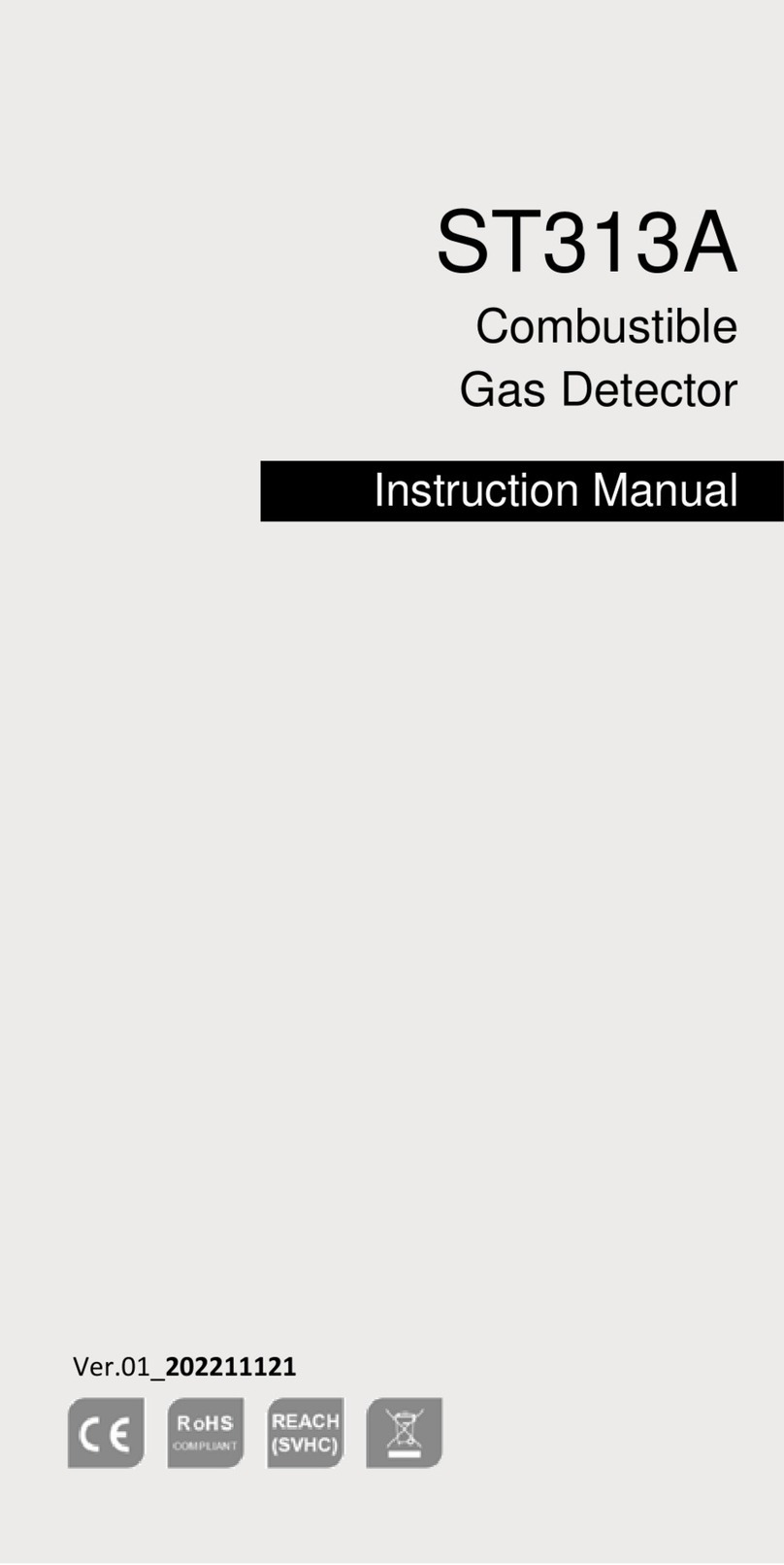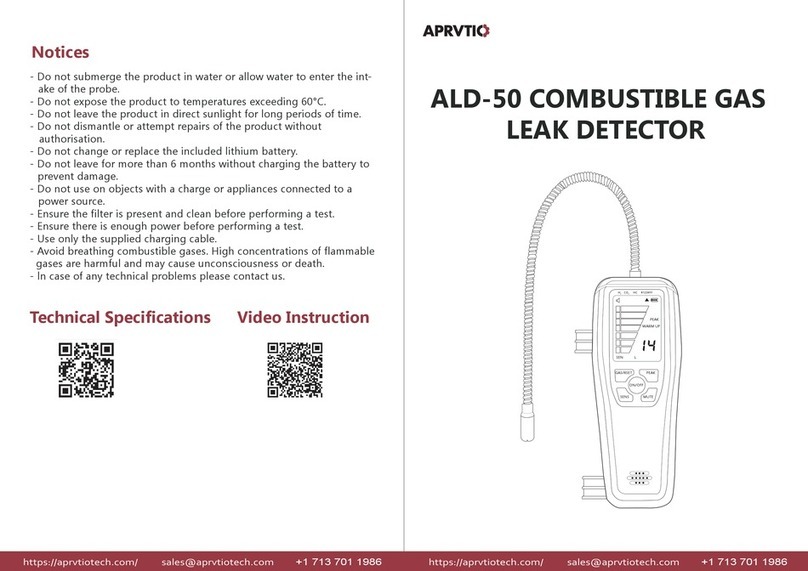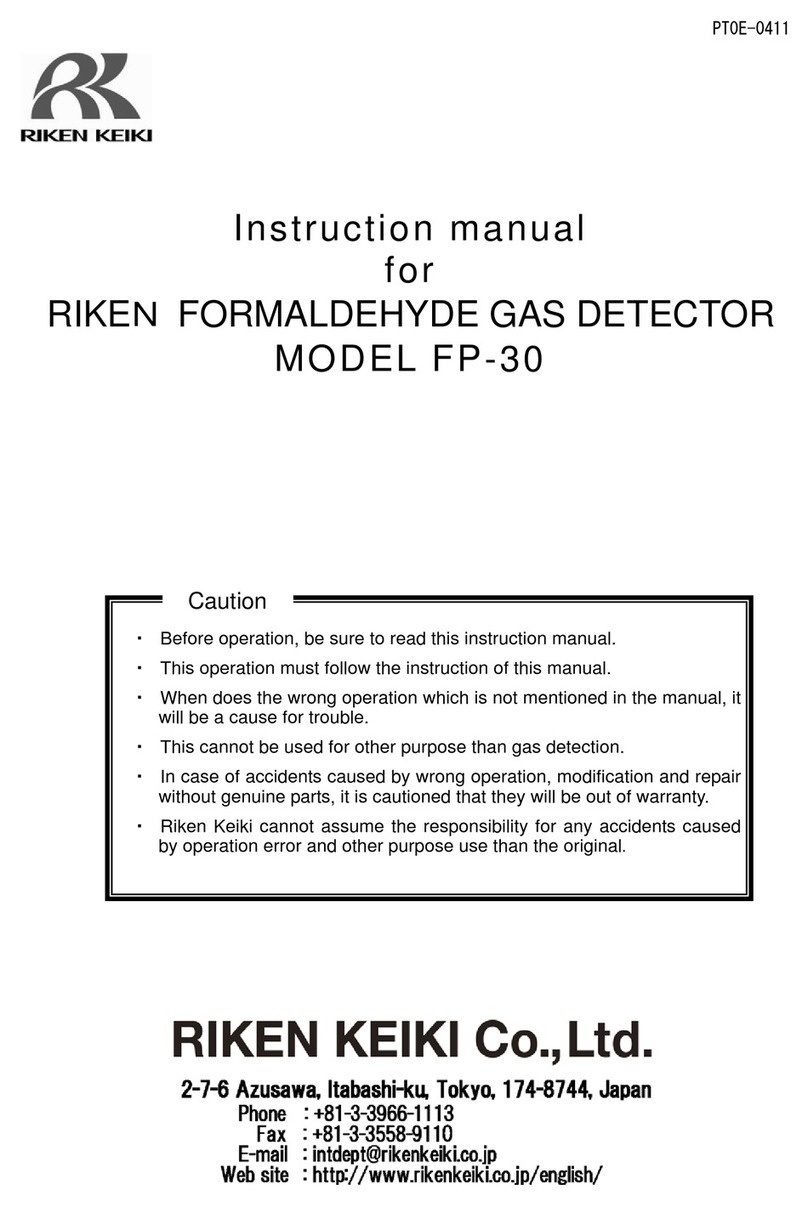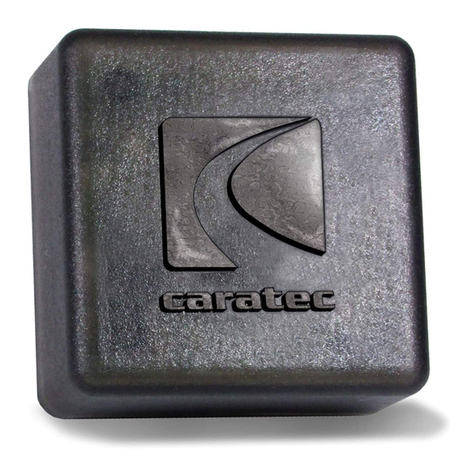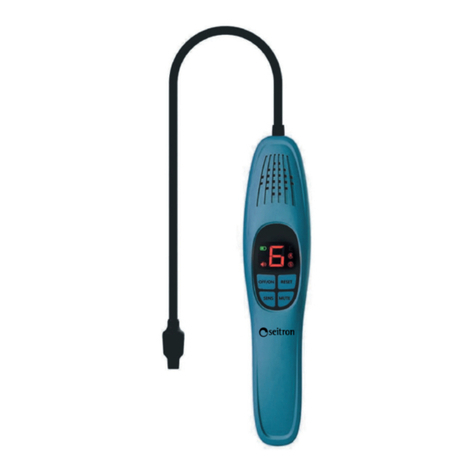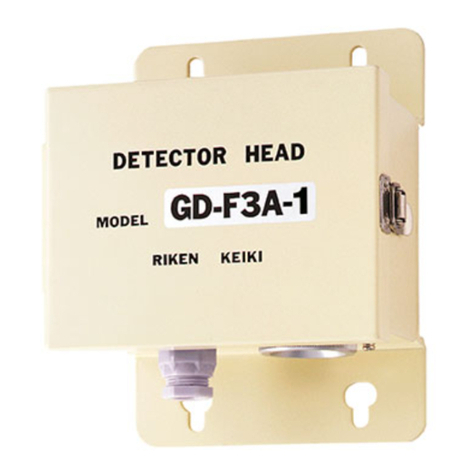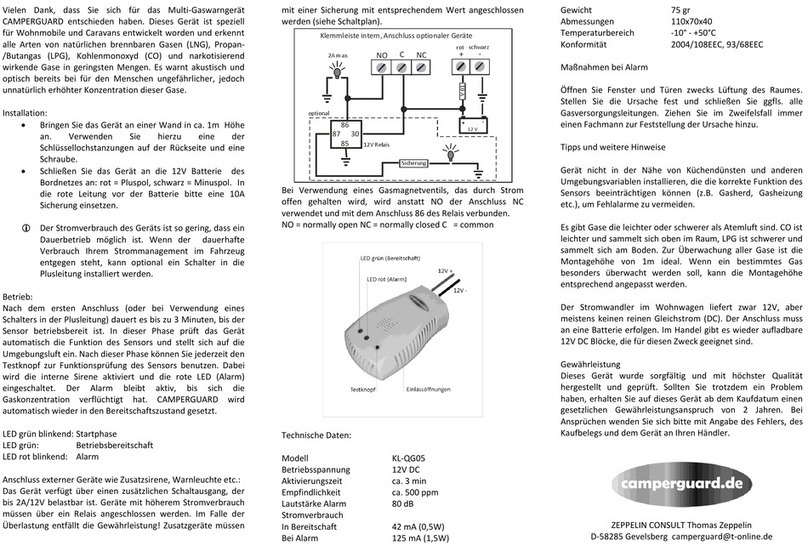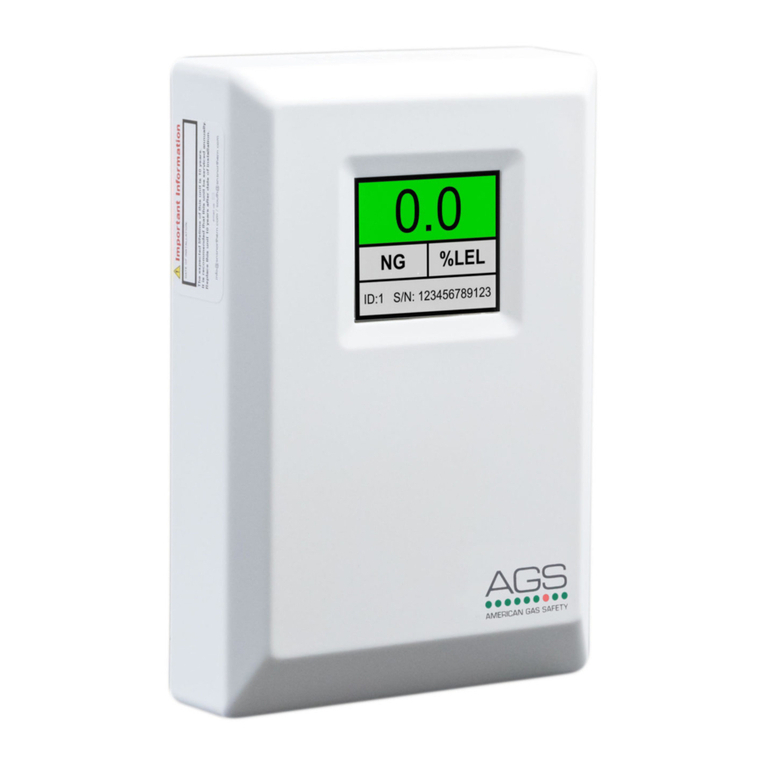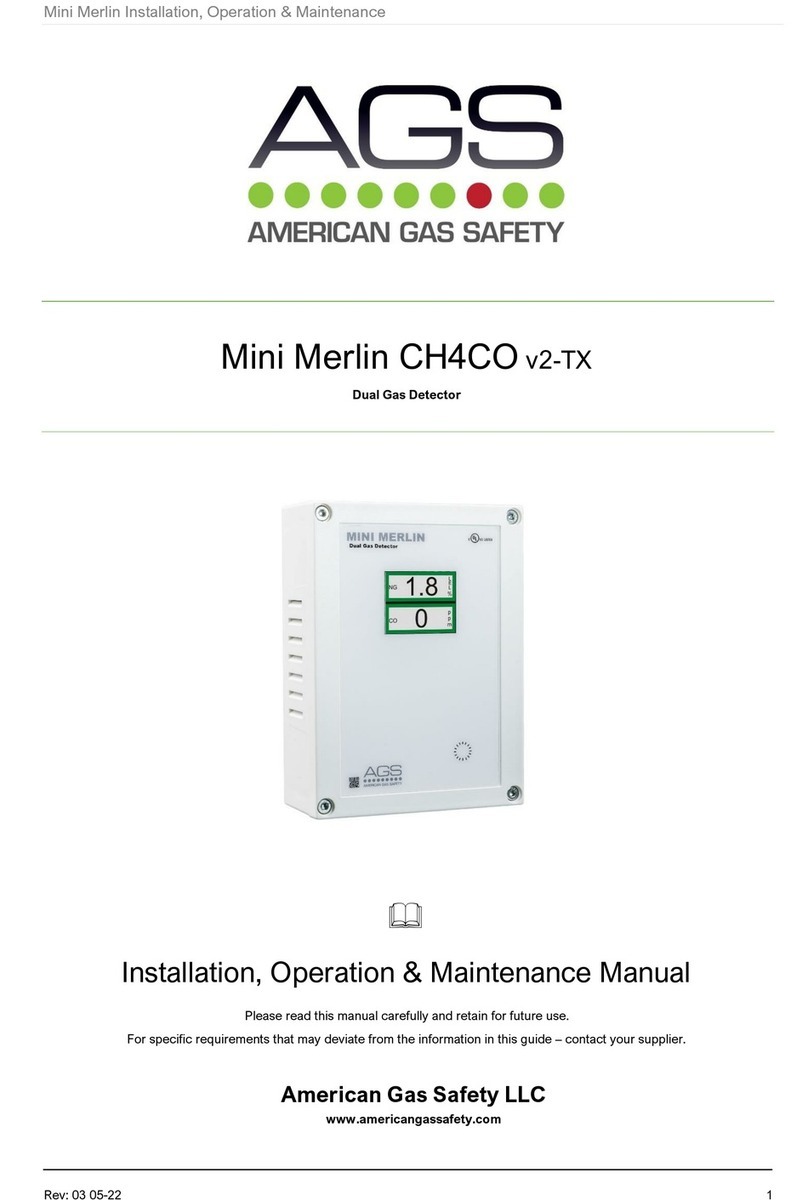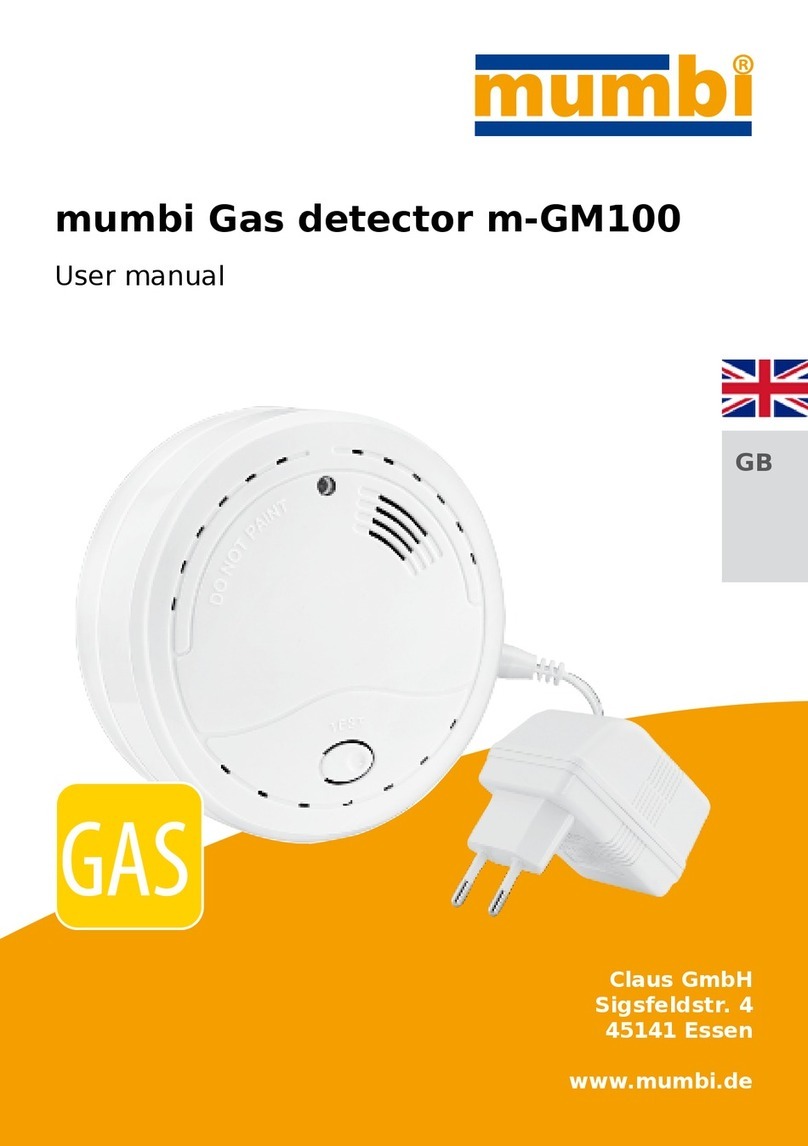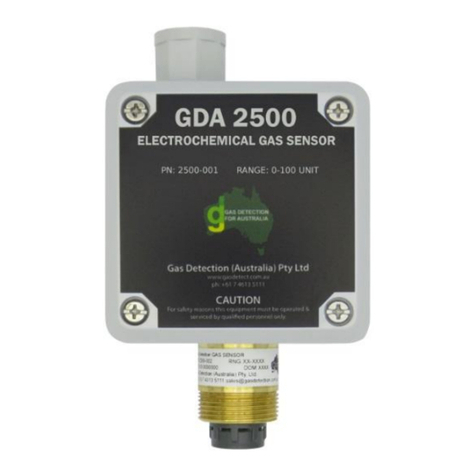STATUS SCIENTIFIC CONTROLS FGD10B Series User manual

STATUS SCIENTIFIC CONTROLS
Issue:
12
Date:
7/1/20
Firmware:
N/A
Installation, Commissioning &
Routine Gas Testing Manual
Gas Detector
Type FGD10B Infrared
Version 2
(with GSH4 Sensor)


Declaration of Conformity
We declare that, on the date the equipment accompanied by this declaration is placed on the market, the equipment conforms with all
technical and regulatory requirements of the directives listed below.
Description of Equipment:
The FGD10 Series of Infrared Fixed Gas Detectors for the detection of Carbon Dioxide or Flammable (Hydrocarbon) gases.
ATEX Flameproof Certified for use in Group IIC hazardous locations.
Directive 2014/34/EU ATEX
The following harmonised standards were used in support of this declaration:
EN 60079-0:2018 Explosive atmospheres Part 0: Equipment –General requirements
The FGD10 was originally certified to standard EN 60079-0:2006. This standard has been compared with the above harmonised standard
and no significant changes have occurred that are applicable this equipment.
EN 60079-1:2014 Explosive atmospheres Part 1: Equipment protection by flameproof enclosures ‘d’.
The FGD10 was originally certified to standard EN 60079-1:2007 but is considered compliant with the above harmonised standard
because both the instrument housing and GSH4 sensor housing are certified to that standard.
Notified Body for Hazardous Area Certification:
CSA Group Netherlands B.V,
Utrechtseweg 310, 6812 AR,
Arnhem,
Netherlands
Notified Body number: 2813
Notified Body for ATEX Quality Assurance Notification:
SGS Fimko Oy
Särkiniementie 3
Helsinki, 00211
Notified Body Number: 0598
Hazardous Area Certificate Number:
SIRA 08ATEX1031X II 2 G Ex d IIC
T4 (Ta = -20OC + 60OC )
T5 (Ta = -20OC + 50OC ) * T5 & T6 ratings are not valid for
T6 (Ta = -20OC + 35OC ) versions fitted with an externally
mounted sensor.
ATEX Quality Assurance Notification Number:
2056
Place of Manufacture:
Mansfield, Nottinghamshire, UK. Date mark applied –see product
ISO 9001:2015 Quality Management System:
Certificate No. GB93/1938
2014/30/EU –Electromagnetic Compatibility
Harmonised Standards:
EN50270:2006 Electromagnetic compatibility - Electrical apparatus for the detection and measurement of combustible gases, toxic gases
or oxygen.
Authorised Signatory to this declaration, on behalf of the manufacturer:
Name: David Stuttard Title: Managing Director
Address: Status Scientific Controls Ltd, Hermitage Lane Industrial Estate, Kings Mill Way
Mansfield, Nottinghamshire, NG18 5ER, United Kingdom
Signature Date: 14/10/19
Extract from TD18/100



STATUS SCIENTIFIC CONTROLS
Installation, Commissioning & Routine Gas Testing
FGD10B Infrared Gas Detector
TD18/006
Issue:
12
Change Note:
1904
Page 6
CONTENTS
1. PACKAGE CONTENTS ......................................................................8
2. SCOPE OF THE MANUAL..................................................................8
3. DESCRIPTION....................................................................................9
3.1. GAS TYPES ...............................................................................10
4. INSTALLATION ................................................................................11
4.1. CABLE ENTRIES.........................................................................12
4.2. MOUNTING AND TERMINAL ACCESS .............................................12
4.3. FGD10B CONNECTIONS ............................................................13
4.4. WIRING DETAILS........................................................................14
4.4.1. FGD10B Infrared................................................................................ 14
5. COMMISSIONING.............................................................................15
5.1. APPLYING POWER......................................................................15
6. RELATIVE RESPONSE CHARACTERISTICS..................................15
7. INITIAL GAS TESTING.....................................................................17
7.1. ZERO GAS.................................................................................17
7.2. TEST GAS .................................................................................19
7.2.1. Gas connection points........................................................................ 19
7.2.2. Sampling time..................................................................................... 20
7.2.3. Suggested calibration gas levels. ...................................................... 20
8. CALIBRATION..................................................................................21
8.1. SENSOR ZERO ..........................................................................21
8.2. SENSOR SPAN ..........................................................................22
8.3. CALIBRATION /CONFIGURATION KEYPAD.....................................23
8.4. MENU MODE SELECTION............................................................25
8.4.1. E : 1 –Sensor Zero............................................................................ 26
8.4.2. E : 2 –Sensor Span ........................................................................... 26
8.4.3. E : 3 –Sensor Fsd.............................................................................. 26
8.4.4. E : 4 –Output Zero (4mA).................................................................. 26
8.4.5. E : 5 –Output Span (20mA)............................................................... 26
8.4.6. E : 9 –Engineer diagnostics .............................................................. 26
8.4.7. E : 77 –Sensor Firmware Version..................................................... 27
9. CALIBRATION..................................................................................28
9.1. SENSOR CALIBRATION ...............................................................28
9.1.1. Sensor Zero........................................................................................ 28
9.1.2. Sensor Span....................................................................................... 29
9.2. ANALOGUE OUTPUT CALIBRATION ..............................................30
9.2.1. Analogue Output Zero........................................................................ 31
9.2.2. Analogue Output Span....................................................................... 31
10. ROUTINE GAS TESTING..................................................................32

STATUS SCIENTIFIC CONTROLS
Installation, Commissioning & Routine Gas Testing
FGD10B Infrared Gas Detector
TD18/006
Issue:
12
Change Note:
1904
Page 7
11. SENSOR REPLACEMENT................................................................33
11.1. INFRARED SENSOR ....................................................................33
12. FUSES ..............................................................................................39
13. SPECIFICATION...............................................................................39
14. DIMENSIONS....................................................................................40
15. CERTIFICATION...............................................................................41

STATUS SCIENTIFIC CONTROLS
Installation, Commissioning & Routine Gas Testing
FGD10B Infrared Gas Detector
TD18/006
Issue:
12
Change Note:
1904
Page 8
1. PACKAGE CONTENTS
The FGD10B is supplied in a box containing the following items:-
Description
Stock
No
FGD10B Gas Detector
*
Installation manual
Calibration certificate
Optional:-
Flow-through sampling adaptor
SS334
Sampling adaptor
SS336
Calibration / Configuration Keypad
SS748
Weather guard
SS841
* Refer to www.status-scientific.com for Stock No’s of the various gas types
available.
2. SCOPE OF THE MANUAL
This manual relates specifically to the version of the FGD10B gas detector
fitted with one of the following sensor types housed in a Type GSH4 sensor
housing:-
•An infrared sensor for the detection of Hydrocarbon (HC) gases.
or
•An infrared sensor for the detection of Carbon dioxide.
Note –Infrared sensors are unsuitable for the detection of Hydrogen.
However, this gas can be detected using a version of the FGD10B fitted
either with pellistors or suitable electro-chemical sensors.

STATUS SCIENTIFIC CONTROLS
Installation, Commissioning & Routine Gas Testing
FGD10B Infrared Gas Detector
TD18/006
Issue:
12
Change Note:
1904
Page 9
Description
The FGD10B is an explosion protected ATEX and IECEx certified fixed gas
detector for use in potentially explosive atmospheres.
The infrared gas sensor is housed within a Type GSH4 certified flameproof
housing, manufactured from stainless steel, attached to the main FGD10B
enclosure.
The FGD10B enclosure is an aluminium die casting. Alternatively, a stainless
steel (larger size) version of the enclosure is also available (suffix –SS).
The unit may be optionally fitted with a protective weather guard as shown in
the following photograph.

STATUS SCIENTIFIC CONTROLS
Installation, Commissioning & Routine Gas Testing
FGD10B Infrared Gas Detector
TD18/006
Issue:
12
Change Note:
1904
Page 10
IMPORTANT –When used in hostile environments (e.g. oil platforms
where the instrument is exposed to salt spray or diesel) it is
recommended that the FGD10B is always fitted with its protective
weather guard. The weather guard is attached with tamperproof screws
to ensure that it is not inadvertently removed.
The unit comprises an instrument housing having two cable gland entries,
one of which is normally fitted with a certified blank, and containing the
connection terminals and electronics.
The housing containing the gas sensor has an M27 thread and is screwed
into the bottom of the unit. The sensor housing itself is a certified component
and must not be removed in service.
The main electrical features of the unit are:-
•Power supply –8 to 24 volts dc (non-intrinsically safe)
•Analogue output –4 to 20mA dc
•Gland entry threads available –20mm, ½” or ¾” NPT
2.1. Gas types
Versions of the FGD10B Infrared are available for detection of gases, fitted
with any of the following sensor types:-
•Infrared - Hydrocarbon
•Infrared –Carbon dioxide
Not suitable for the detection of hydrogen

STATUS SCIENTIFIC CONTROLS
Installation, Commissioning & Routine Gas Testing
FGD10B Infrared Gas Detector
TD18/006
Issue:
12
Change Note:
1904
Page 11
3. INSTALLATION
It is important that the correct cable and gland types are used when installing
the FGD10B in a hazardous location.
The cable entry devices and blanking elements of unused apertures shall be
of a certified flameproof type, suitable for the conditions of use and correctly
installed.
With the use of conduit, a suitable certified sealing device such as a stopping
box with compound shall be provided immediately at the entrance to the
flameproof enclosure.
In order to prevent dangerous overloading of the FGD10B gas detector, it is
fitted with an internal self resetting fuse which limits the maximum allowable
power dissipation.
Guidance on the correct installation of systems is provided by EN60079-14:
2014. It is the responsibility of the installer to ensure compliance with the
relevant standards.
To ensure effective gas detection, the FGD10B must be located at a height
appropriate to the density of the target gas relative to air. For example,
Methane (relative density 0.55) is lighter than air and so it will tend to
accumulate at a high level within a confined space. Whereas Petroleum
(relative density 2.8) is heavier than air and it will tend to accumulate at
around ground level.
We recommend the user to make reference to European standard
EN 60079-20-1:2019 which provides comprehensive gas flammability data
(including relative density).

STATUS SCIENTIFIC CONTROLS
Installation, Commissioning & Routine Gas Testing
FGD10B Infrared Gas Detector
TD18/006
Issue:
12
Change Note:
1904
Page 12
Cable entries
The cable entry threads are 20mm, ½” or ¾” NPT female.
The FGD10B enclosure is manufactured from die cast aluminium (stainless
steel versions are also available). Therefore, the use of glands, conduit
fittings and blanks made from brass should be avoided because if moisture is
present, bi-metallic corrosion may occur due to the chemical reaction
between the two materials.
Glands and fittings plated with nickel, tin or zinc will provide improved
protection but in harsh environments the use of stainless steel is
recommended.
When connecting the cores inside the unit it is beneficial to use pointed-nose
pliers to carefully guide the cable cores from the cable entries at the rear of
the enclosure towards the PCB mounted terminal connections situated near
to the middle of the enclosure.
3.1. Mounting and terminal access
The FGD10B should be mounted and secured using the mounting holes on
the main unit.
Figures 2 and 3 shows details of the FGD10B terminal connections –these
can be accessed as follows:-.
1. Switch OFF the supply to the FGD10B.
2. Release the locking screw located near the lip of the enclosure
cover by rotating clockwise.
3. Remove the enclosure front cover by rotating it several times in
an anti-clockwise direction.
4. The terminals can now be accessed.
Locking Screw

STATUS SCIENTIFIC CONTROLS
Installation, Commissioning & Routine Gas Testing
FGD10B Infrared Gas Detector
TD18/006
Issue:
12
Change Note:
1904
Page 13
FGD10B connections
Figure 2 –Armoured Cable Gland Installation
Figure 3 –EEx d Conduit Installation

STATUS SCIENTIFIC CONTROLS
Installation, Commissioning & Routine Gas Testing
FGD10B Infrared Gas Detector
TD18/006
Issue:
12
Change Note:
1904
Page 14
3.2. Wiring details
3.2.1. FGD10B Infrared
The infrared gas detector is powered from a 8 –24 volt dc, 5W maximum
output supply with a separate connection for the 4 –20 mA output and as
such requires 3 wires, see following diagram.
Source
A+
0V
8- 24 V DC
I( 4- 20mA)
PSU
Zero
Span
Sink
Source
Fig 4a
Sink
A+
0V
8-
24 V DC
I( 4- 20mA)
PSU
Zero
Span
Sink
Source
Fig 4b

STATUS SCIENTIFIC CONTROLS
Installation, Commissioning & Routine Gas Testing
FGD10B Infrared Gas Detector
TD18/006
Issue:
12
Change Note:
1904
Page 15
4. COMMISSIONING
Following completion of the installation:-
Ensure that the front cover has not been contaminated with dirt - paying
particular attention to the thread. Replace the cover by rotating it several
times clockwise until it reaches its limit then secure using the locking screw,
turning in an anti-clockwise direction –do not over tighten.
4.1. Applying power
Once the installation is complete and the covers are secure then power can
be applied. The power source should be between 12 and 24 volts dc.
5. RELATIVE RESPONSE CHARACTERISTICS
Unless otherwise specified, the FGD10B infrared hydrocarbon gas detector
is calibrated to provide an output signal linearised for methane (CH4) during
manufacture.
Note: the cross reference data was obtained using the lower explosive level
for methane as 5% v/v.
However, the gas detector will also respond to a range of hydrocarbon
gases. The characteristics shown in Figure 5 demonstrate the relative
response to some of the common hydrocarbons.
If the expected target gas is other than methane then either:-
a) The characteristics can be used as a guide when setting up the alarm
levels in the associated control unit, e.g. where a general hydrocarbon
response is required.
b) The FGD10B can be fitted with a sensor that is characterised for different
gases, contact Status Scientific Controls.

STATUS SCIENTIFIC CONTROLS
Installation, Commissioning & Routine Gas Testing
FGD10B Infrared Gas Detector
TD18/006
Issue:
12
Change Note:
1904
Page 16

STATUS SCIENTIFIC CONTROLS
Installation, Commissioning & Routine Gas Testing
FGD10B Infrared Gas Detector
TD18/006
Issue:
12
Change Note:
1904
Page 17
Initial Gas Testing
FGD10B units are factory calibrated as detailed on the calibration certificate
supplied with the instrument. However, it is always advisable after installation
to confirm that the instrument reads zero with no gas present and responds
accurately when presented with an appropriate concentration of the target
gas.
The FGD10B sensor should be allowed to stabilise for the period specified
on the associated calibration certificate before attempting to check the zero
setting and gas response.
5.1. Zero gas
With no gas present check that the associated control panel display reads
zero.
a) If the instrument reads zero then no adjustment is required and gas
response testing may now be carried out as described in Section 5.2.
b) If the instrument does not read zero then adjustment of the zero setting
is required as described in Section 6.1.1. - Sensor Zero.
c) If the analogue signal is connected to an associated control panel,
confirm that when the FGD10B display reads zero, the control panel
display also reads zero or, adjust as necessary in accordance with the
control panel manufacturers’ instructions.
* Note –If there is the possibility of a background gas being present then
zeroing of the detector should be carried out using a test gas cylinder of air in
nitrogen.

STATUS SCIENTIFIC CONTROLS
Installation, Commissioning & Routine Gas Testing
FGD10B Infrared Gas Detector
TD18/006
Issue:
12
Change Note:
1904
Page 18
Figure 7 –Arrangement for Application of a Certified Test Gas
Certified
Calibration Gas
Cylinder
Remote
Sampling Point
6mm OD Tubing
Flow regulator
1L/Min
Sampling
Adaptor

STATUS SCIENTIFIC CONTROLS
Installation, Commissioning & Routine Gas Testing
FGD10B Infrared Gas Detector
TD18/006
Issue:
12
Change Note:
1904
Page 19
5.2. Test gas
Figure 7 shows a typical arrangement for the application of a certified test
gas.
The purpose of the test gas response check is to confirm that that the
reading on the instrument corresponds with the test gas concentration.
a) If the associated control panel reads correctly then no adjustment is
required.
b) If the above checks are satisfactory then the installation is now
complete.
c) If the instrument does not read correctly then adjustment of the sensor
span setting is required as described in Section 6.1.2. - Sensor Span.
5.2.1. Gas connection points
Certified test gas can be applied either:-
a). directly to the FGD10B via the appropriate sampling/calibration adaptor.
or
b). remotely, by connecting a test gas sampling tube to the appropriate
sampling/calibration adaptor and installing a test point at the remote end of
the tube.
Method b) avoids the need to gain direct access to the unit in order to carry
out routine gas testing. The sample tube should be taken to a convenient
point and sited such that the risk of contamination is minimised. A means
must be provided to ‘cap off’ the tube when not in use in order to prevent
blockage.
The weather guard is provided with a 6mm O.D. push in tube connector to
allow connection of a gas sampling tube. Firstly, remove the blanking plug by
depressing the coloured plastic ring whilst pulling on the plug; now push in
the gas sampling tube. The standard fitting is a push fit connector for 6mm
O.D tubing. The connector is screwed into a 1/8” BSP thread; other fittings
are available on request.
Where a weather guard is not fitted, the use of a sampling adaptor (Stock
No. SS336) is required in order to present the gas to the FGD10B sensor.

STATUS SCIENTIFIC CONTROLS
Installation, Commissioning & Routine Gas Testing
FGD10B Infrared Gas Detector
TD18/006
Issue:
12
Change Note:
1904
Page 20
5.2.2. Sampling time
Apply the test gas and allow a sufficient time for the sample to reach the gas
detector. The response time will vary according to the length of the sampling
tube.
5.2.3. Suggested calibration gas levels.
Hydrocarbon sensor:
Zero gas free air.
Span 2.5%v/v Methane.
Carbon dioxide sensor
Zero Nitrogen.
Span 2.5%v/v CO2.
Other manuals for FGD10B Series
1
Table of contents
Other STATUS SCIENTIFIC CONTROLS Gas Detector manuals

STATUS SCIENTIFIC CONTROLS
STATUS SCIENTIFIC CONTROLS FGD10B Series Guide
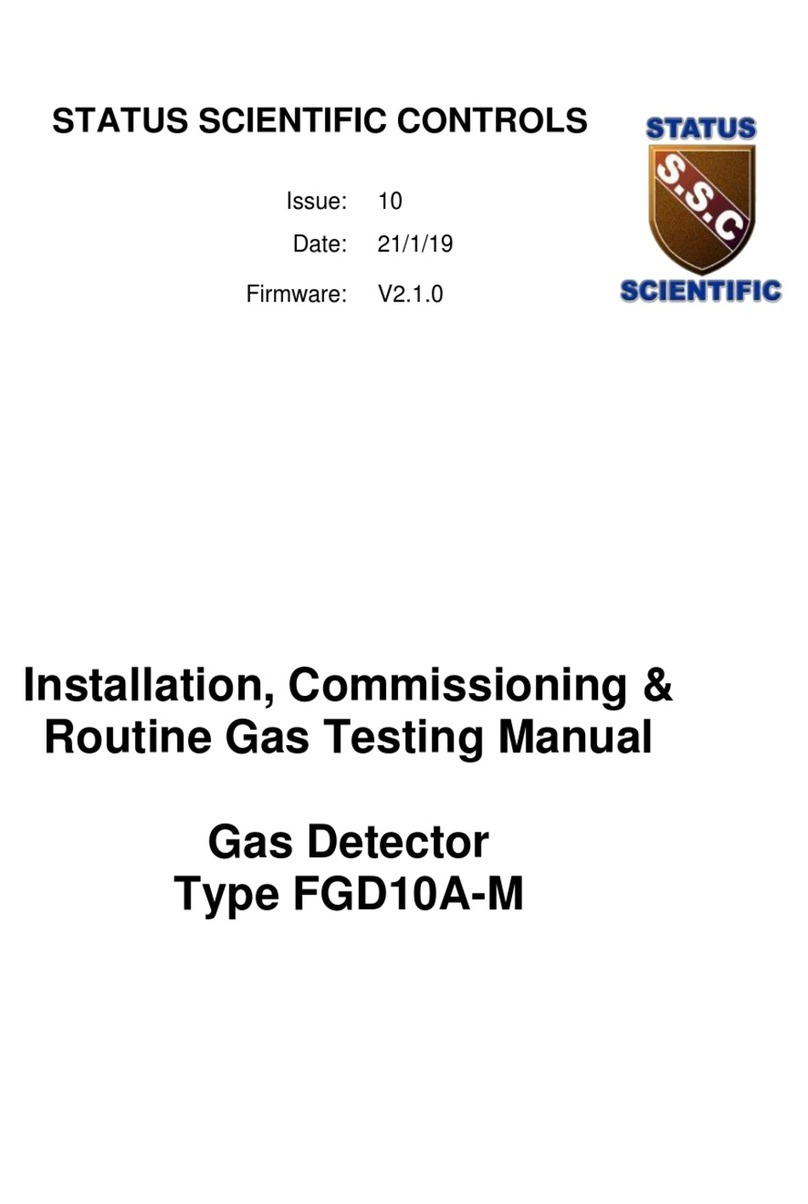
STATUS SCIENTIFIC CONTROLS
STATUS SCIENTIFIC CONTROLS FGD10A-M User manual

STATUS SCIENTIFIC CONTROLS
STATUS SCIENTIFIC CONTROLS FGD 3 Series User manual
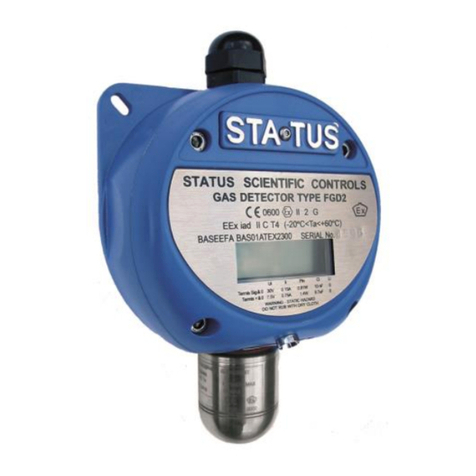
STATUS SCIENTIFIC CONTROLS
STATUS SCIENTIFIC CONTROLS FGD2 User manual
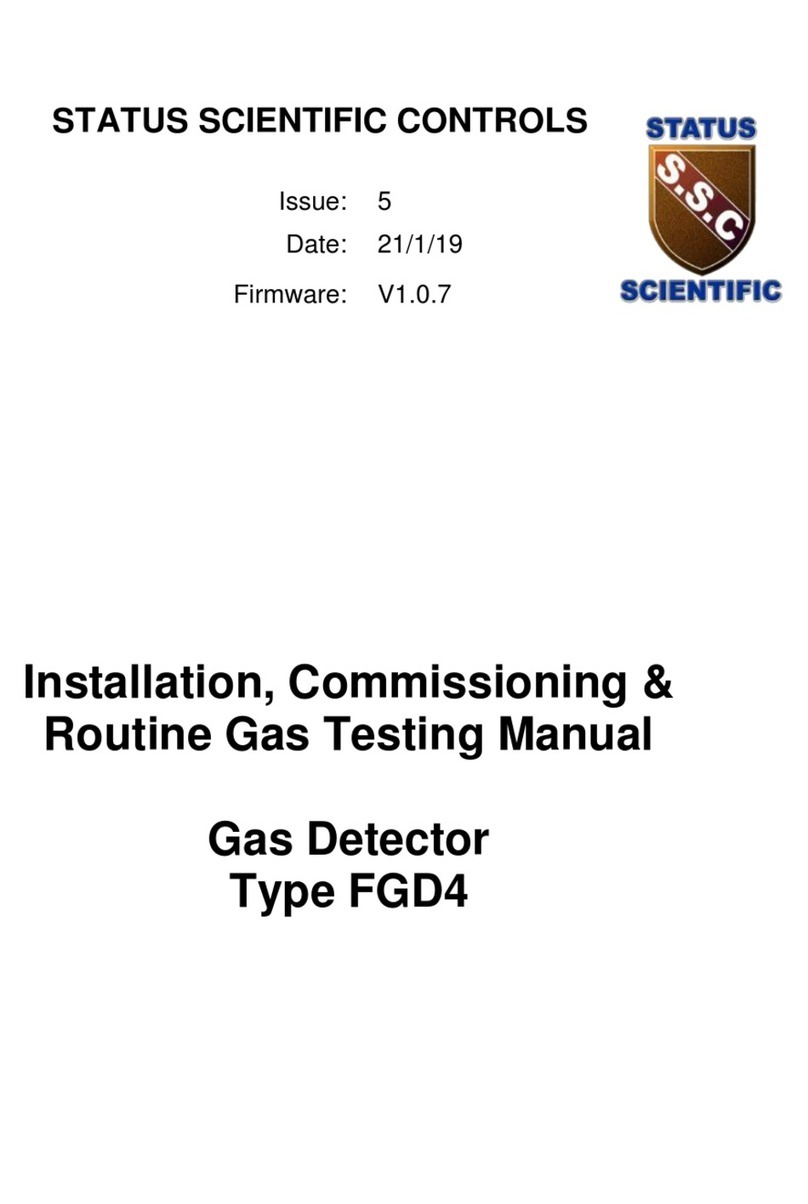
STATUS SCIENTIFIC CONTROLS
STATUS SCIENTIFIC CONTROLS FGD4 User manual

STATUS SCIENTIFIC CONTROLS
STATUS SCIENTIFIC CONTROLS FGD10A User manual
